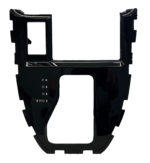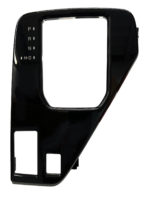Hot-Cold Molding & CO2 Laser: Technologies for Seamless Design
June 24, 2024 • Posted in In Mold Labeling
While the world injection molding technology is constantly advancing, challenges remain in producing plastic parts that are free of molded-in stress. In other words: lines or seams.
For a part with high aesthetic requirements, there have traditionally been two options. For one, moving the weld line to the back of a part to hide its existence has been a long-time practice for many manufacturers. However, hiding isn’t the same as eliminating, and a small line may still be discoverable by consumers depending on the viewing angle (which can look like a defect or scratch).
There’s also the option of buffing the line away to “smooth over” the look of the seam. This process adds extra time and costs, and can also change the design function and intent. Not perfect.
At Sanwa, instead we are able to use two highly-advanced technologies that can provide a better solution — effectively eliminating the weld line and any weaknesses that may result from a depression in a part.

What are weld lines?
How do weld lines happen? When resin enters an injection mold, it flows into the cavity to fill the part. If there’s a hole in the final part design (imagine a dashboard with holes for buttons or knobs), then the resin must flow around it. When it comes back together, the joining point of the resin creates a weld line.
This is also known as a knit line, visible flow line, seam, or silver streak.
One way to imagine how a weld line forms is by thinking about Play Doh or pizza dough! If you roll the dough out into a long cylinder and then join the ends, there’s a visible line where they meet.
What is Hot-Cold Molding?
During the hot-cold molding process, heaters are applied to raise the mold surface temperature prior to the resin entering the cavity, and then subsequently cool the cavity once it’s filled. The heater is controlled by a machine that adjusts the temperature, so that when the resin flows back together again, the area is hotter and the resin can more easily join with itself — eliminating the weld line.
Hot-cold molding is gaining acceptance in automotive interior and consumer goods applications requiring top-quality surface aesthetics. It can hide flow lines and improve quality, and also facilitate special characteristics, such as metallic effects or simulated pattern stitching, without the need for secondary process steps.

What is CO2 Laser Cutting?
Simply put, CO2 laser cutting uses a laser beam to cut through the surface of a material, which improves the finish. CO2 laser cutting provides an alternative to blades or clippers, and delivers finely-tuned results with the use of special programming.
The laser beam is sealed in glass and cuts with both precision and speed. While many CO2 laser cutting machines are capable of multi-material cutting without changing tools (wood, metal, ceramics, etc.), at Sanwa, we exclusively use the technology for cutting plastics. Using computer aided design software, detailed instructions are transmitted to the machine which enables a highly automated process.
CO2 laser beams can complete a large number of cuts over time and handle complex patterns, far exceeding traditional cutting methods. This is especially useful for high-volume parts requiring the utmost-level of consistency, such as automotive manufacturing.
Benefits of CO2 laser cutting include:
A smooth, clean finish
Predictable and repeatable cutting locations
Speed
Automation and program control
Reduced product waste
Precision for cutting fine lines and acute angles

Ready to enter the world of seamless design?
CO2 laser cutting and hot-cold molding are both indispensable technologies when it comes to delivering high-end, seamless parts. Today’s consumers have a discerning eye, and we now have the ability to produce parts that are free of knit lines while maintaining a high level of speed and accuracy. This provides assurance to our customers, while improving our production times and reducing overall manufacturing waste.
Contact us if you’d like to start a conversation about using hot-cold molding or CO2 laser cutting to bring your product to market. With over 45 years of experience working with some of the top names in auto and appliance, we’ve got the processes and capabilities to give your plastic components — and completed product — a competitive edge.